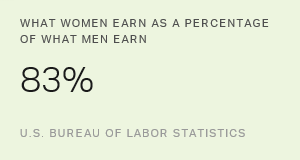Story Highlights
- Men report working more hours per week than women do
- Perceptions of hours worked can influence pay
- There's a wide range of approaches to evaluating and compensating time
This article is the first in a two-part series.
The gender pay gap is one of the most controversial topics related to women and work.
Though less pronounced than in the past, the pay gap still exists and has barely budged in over a decade. Estimates of the gender pay gap and the methodology behind it vary, but all essentially reach the same conclusion: Women earn less than men.
The U.S. Bureau of Labor Statistics (BLS) estimates that full-time working women make 83% of what full-time working men make. The U.S. Census Bureau reports that women who hold full-time jobs earn 79 cents for every dollar that men with full-time jobs earn. The gap is even more pronounced for African-American and Latina women, who earn 64 cents and 56 cents, respectively, for every dollar that white, non-Hispanic men earn.
No single explanation can account for the differences in men's and women's paychecks. In Gallup's report, Women in America: Work and Life Well-Lived, we chose to focus on two underlying reasons for the gender pay gap: hours worked and perceptions of hours worked.
Men Report Working More Hours per Week Than Women Do
In the U.S. workforce, 47% of men say they work more than 40 hours per week, while 30% of women say the same.
| Men full time | Women full time | ||||||||||||||||||||||||||||||||||||||||||||||||||||||||||||||||||||||||||||||||||||||||||||||||||
|---|---|---|---|---|---|---|---|---|---|---|---|---|---|---|---|---|---|---|---|---|---|---|---|---|---|---|---|---|---|---|---|---|---|---|---|---|---|---|---|---|---|---|---|---|---|---|---|---|---|---|---|---|---|---|---|---|---|---|---|---|---|---|---|---|---|---|---|---|---|---|---|---|---|---|---|---|---|---|---|---|---|---|---|---|---|---|---|---|---|---|---|---|---|---|---|---|---|---|---|
| % | % | ||||||||||||||||||||||||||||||||||||||||||||||||||||||||||||||||||||||||||||||||||||||||||||||||||
| Work 60 or more hours per week | 14 | 7 | |||||||||||||||||||||||||||||||||||||||||||||||||||||||||||||||||||||||||||||||||||||||||||||||||
| Work 50-59 hours per week | 21 | 11 | |||||||||||||||||||||||||||||||||||||||||||||||||||||||||||||||||||||||||||||||||||||||||||||||||
| Work 41-49 hours per week | 12 | 12 | |||||||||||||||||||||||||||||||||||||||||||||||||||||||||||||||||||||||||||||||||||||||||||||||||
| Work 40 hours per week | 47 | 56 | |||||||||||||||||||||||||||||||||||||||||||||||||||||||||||||||||||||||||||||||||||||||||||||||||
| Work less than 40 hours per week | 7 | 15 | |||||||||||||||||||||||||||||||||||||||||||||||||||||||||||||||||||||||||||||||||||||||||||||||||
| Data do not account for occupation type or hourly versus salaried positions | |||||||||||||||||||||||||||||||||||||||||||||||||||||||||||||||||||||||||||||||||||||||||||||||||||
| Gallup | |||||||||||||||||||||||||||||||||||||||||||||||||||||||||||||||||||||||||||||||||||||||||||||||||||
Gallup made a similar discovery when looking at hours data by occupation type and hourly versus salaried positions. Men consistently report working more hours per week than women do. In salaried roles, for example, 28% of men say they work 50 to 59 hours per week, compared with 16% of women who say the same. In hourly roles, 10% of men say they work 60 or more hours per week, compared with 3% of women.
While men say they work more hours at their jobs than women do, these findings do not suggest that men work harder than women. The much more likely scenario is that women often work two jobs: as mothers and as full-time or part-time employees. Working mothers tend to have fewer hours in their day to give to their jobs. They have children to pick up from school and take to baseball or dance practice, homework to supervise, laundry to fold and a family to feed.
While there are certainly working fathers who participate in these stereotypically maternal activities, the reality is that women are still the primary caregivers with the majority of oversight for their homes and families.
Through its American Time Use Survey, the BLS found that 85% of women and 67% of men spend some time doing household activities (for example, housework, cooking, lawn care) in an average day. Women spend an average of 2.6 hours on these activities, while men spend an average of 2.1 hours on them. In households with children younger than 6, women spend an average of 2.2 hours per day providing physical care for a child or children (for example, bathing or feeding them); the average for men is 1.5 hours.
In general, women spend 2.3 hours per day caring for and helping household members; the average for men is 1.6 hours. When averaged over the course of a week, women spend 16.1 hours caring for and helping household members, and men spend 11.2 hours.
Because women spend more time on household and childcare responsibilities, they have less time to devote to work, email or traveling for business. When examining the number of hours that women and men work, Gallup found that women in salaried positions who have a child younger than 18 work the fewest hours compared with other employees.
| Average number of hours per week | |||||||||||||||||||||||||||||||||||||||||||||||||||||||||||||||||||||||||||||||||||||||||||||||||||
|---|---|---|---|---|---|---|---|---|---|---|---|---|---|---|---|---|---|---|---|---|---|---|---|---|---|---|---|---|---|---|---|---|---|---|---|---|---|---|---|---|---|---|---|---|---|---|---|---|---|---|---|---|---|---|---|---|---|---|---|---|---|---|---|---|---|---|---|---|---|---|---|---|---|---|---|---|---|---|---|---|---|---|---|---|---|---|---|---|---|---|---|---|---|---|---|---|---|---|---|
| Women with a child younger than 18 | 43 | ||||||||||||||||||||||||||||||||||||||||||||||||||||||||||||||||||||||||||||||||||||||||||||||||||
| Women without a child younger than 18 | 44 | ||||||||||||||||||||||||||||||||||||||||||||||||||||||||||||||||||||||||||||||||||||||||||||||||||
| Men without a child younger than 18 | 46 | ||||||||||||||||||||||||||||||||||||||||||||||||||||||||||||||||||||||||||||||||||||||||||||||||||
| Men with a child younger than 18 | 47 | ||||||||||||||||||||||||||||||||||||||||||||||||||||||||||||||||||||||||||||||||||||||||||||||||||
| Data are for salaried employees | |||||||||||||||||||||||||||||||||||||||||||||||||||||||||||||||||||||||||||||||||||||||||||||||||||
| Gallup | |||||||||||||||||||||||||||||||||||||||||||||||||||||||||||||||||||||||||||||||||||||||||||||||||||
Perceptions of Hours Worked Can Also Influence Pay
Compensation and time sheets often go hand in hand, especially in hourly positions. But beyond actual hours clocked, perceptions of time spent in the office can also suppress women's paychecks as well as their opportunities for bonuses and career growth -- in hourly and salaried positions. A 2016 survey from the American Payroll Association found that 36% of respondents work for a company that doesn't require them to record the number of hours they work.
From our qualitative work, Gallup has also discovered that some employees who are required to log their hours are directed to log only 40 hours per week, regardless of how many hours they actually work. Many organizational cultures reward employees who are simply at the office more, even though their outcomes or contributions are not indicative of greater performance.
Too often, managers rate and reward employees on the basis of their own perceptions and misguided notions of intensity. They believe that the people who are in the office 50 hours a week are better performers or harder workers than those who are in the office 40 hours a week. In reality, 40-hour-a-week employees may be working with greater intensity, performance and outcomes than their 50-hour-a-week counterparts. Yet, the 40-hour-a-week employees may be perceived as not working as hard because they are not putting in enough face time.
Time Is Money
Performance management and the value of hours can quickly become dicey subjects. Gallup believes that performance management is one of the most defining topics of the current and future workplace. We are studying it extensively and will continue to do so. We know that time absolutely matters in the workplace, but we also know that organizations have a wide range of approaches to how they evaluate and compensate time. No single standard works for all companies, but all companies should be equitable in their methods.
Whatever the metrics, companies must compare, rank and rate their employees based on the expectations of the department or team but ideally prioritize the employees and their individual strengths and goals. In the best work environments, organizations categorize and evaluate employees according to who works part time, three-fourths time, full time and beyond full time. Employees in the part-time category aren't measured against those in the beyond-full-time category, but all have an opportunity for rewards.
The next article in this series will provide further insight into how organizations can better align pay with outcomes.
Learn more about what it takes to attract, engage and retain a gender-diverse workforce. Download Women in America: Work and Life Well-Lived.



